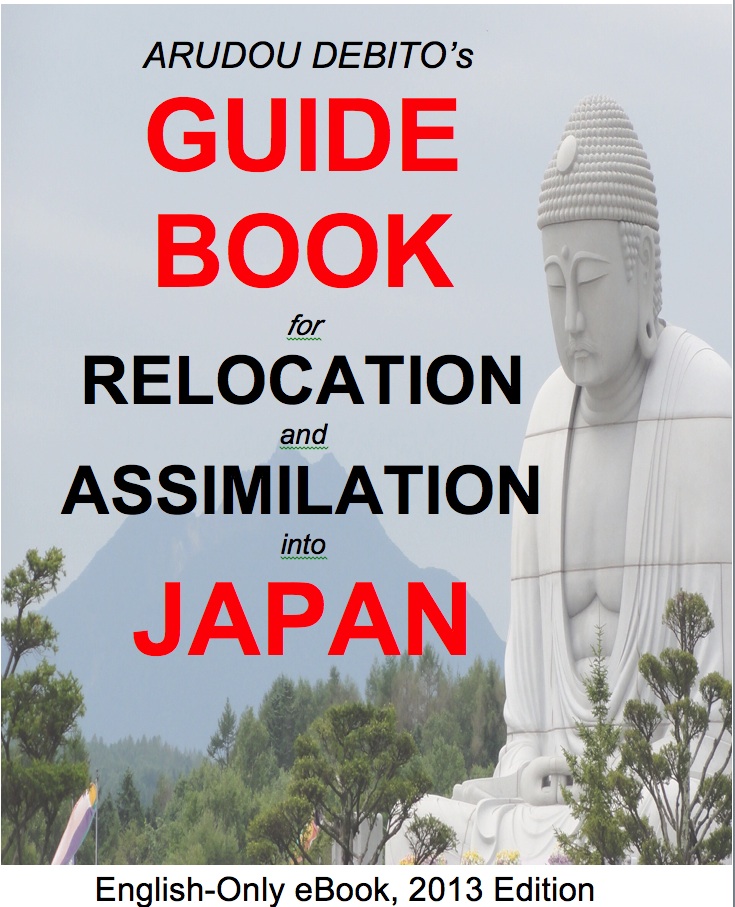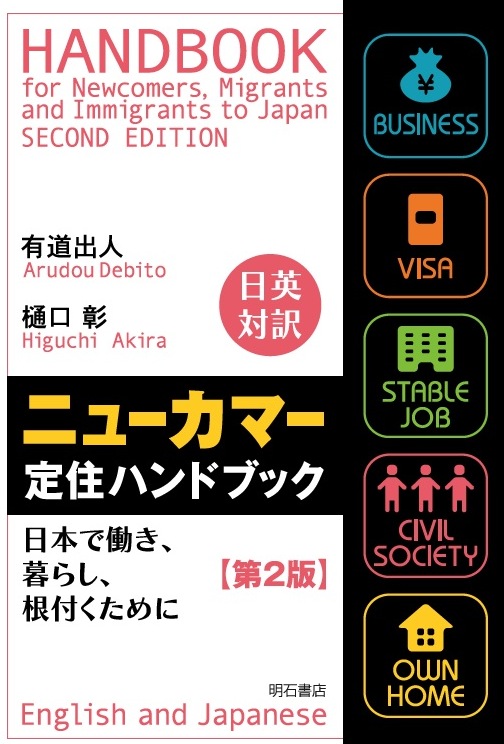mytest
Books, eBooks, and more from Dr. Debito Arudou (click on icon):





![]()


UPDATES ON TWITTER: arudoudebito
DEBITO.ORG PODCASTS on iTunes, subscribe free
“LIKE” US on Facebook at http://www.facebook.com/debitoorg
https://www.facebook.com/embeddedrcsmJapan
http://www.facebook.com/handbookimmigrants
https://www.facebook.com/JapaneseOnlyTheBook
https://www.facebook.com/BookInAppropriate
If you like what you read and discuss on Debito.org, please consider helping us stop hackers and defray maintenance costs with a little donation via my webhoster:

All donations go towards website costs only. Thanks for your support!
Hi Blog. Here’s an earnest Japan Times journalist trying to take on some nasty anti-foreign signs up in a prominent Tokyo shopping area. The article cites me at the end, thanks. Read on for another comment from me that didn’t make the cut. Dr. Debito Arudou
//////////////////////////////////////
Tackling signs in Japan that you’re not welcome
BY DAISUKE KIKUCHI
The Japan Times, June 4, 2017
Entire article at http://www.japantimes.co.jp/news/2017/06/04/national/tackling-signs-japan-youre-not-welcome/
“MOTHER F——- KISS MY ANUS. F—- OFF Mother F——-… foreigner. Sneaking PHOTO.”
A hand-written sign bearing these words is among several decorated with similar insults that greet shoppers outside a fashion store that sells rock-style clothing in Tokyo. The sign sits among shirts emblazoned with designs featuring overseas rock bands such as Iron Maiden, Children Of Bodom and Marilyn Manson in the fashion and kawaii culture mecca of Harajuku’s Takeshita Street in Shibuya Ward.
The Japan Times visited the shop after being approached by a foreign resident who was disgusted to see the signs while he was with his young daughter.
“The shop is absolutely covered in these messages,” wrote the reader. “I walk past this place from time to time. The thing that annoys me most is that Harajuku is such an anything-goes area full of all kinds of subcultures and minorities, not least of all foreigners, so this place is like a nasty little pit of intolerance inside an oasis of colour and joy.”
Asked about the thinking behind the signs, a staff member at the store explained that the shop put them up after becoming frustrated by the terrible manners of foreign shoppers.
“They usually take pictures, without permission,” said the staff member. The shop is concerned about images of its products being uploaded to the internet, she said. As to whether they would consider taking down the sign, she added: “I’m not so sure. If (they) had good manners, we wouldn’t do this, but there are so many that have really bad manners.”
[…]
In 2002 the Sapporo District Court ordered a bathhouse in Otaru, Hokkaido, to pay ¥1 million each in damages to three plaintiffs refused entry because they did not look Japanese. This ruling was based on articles of the civil code protecting individual rights and authorizing damages when these rights are violated, Article 14 of the Constitution — which forbids discrimination — and international conventions on racial discrimination and civil rights. However, the court did not uphold the plaintiffs’ claim against the city for its failure to implement an ordinance against racial discrimination based on the international pact cited in the Bortz case. That verdict was confirmed by the Sapporo High Court.
Debito Arudou, a plaintiff in the Otaru case and a columnist for The Japan Times who writes about human rights, hosted a “Rogues Gallery” of “Japanese only” and other discriminatory signs found across the country on his website, Debito.org, in the years after the Otaru case. There, readers could post photos of signs they found locally or on their travels, as well as any measures taken to get those signs removed, some of which proved successful.
“After the Otaru onsens case, bigoted shopkeeps realized they could put up ‘Japanese only’ signs with impunity, and they proliferated around Japan,” explains Arudou. “I dropped by those places, asked ‘Why this sign?’ and what could we do about it.
“Most managers adamantly denied any racism on their part, until I asked if someone like I, a Caucasian with a Japanese passport, could come in. When they said no, I pointed out the racism, to which they just shifted tack and blamed their racist customers. When they said yes, I often came inside and got more information about what was necessary to get the signs down. When they said they’ll think about it and I should come back later, I did and was usually denied entry again. I’d say each situation happened about a third of the time.
“We did get several signs down,” Arudou says. “Part of it was by calm persuasion about what how unenforceable the policy was: How were they to decide who was Japanese, especially when I was proving it was possible to be one without looking like one — and what about Japan’s international children? Part of it was the need to make the rules clear despite a language barrier. I listened to their rules, wrote up a bilingual sign for them to display, and received their exclusionary sign in trade. And part of it was quietly pulling signs down in the middle of the night. They didn’t go back up.”
Based on his experiences, Arudou advises engaging with business owners displaying discriminatory signs.
“If you have the language ability, or a friend or native speaker who is so inclined, ask the manager why the sign is up, and what it would take to get it down,” Arudou says. “After all, we shouldn’t allow racist behavior to be normalized through public signage. And if that doesn’t work, of course, I would never advocate that people pull the signs down quietly in the middle of the night. Never ever.”
ENDS
///////////////////////////////
NB: I also commented directly about the signs that open this article, which didn’t make the cut:
=====================================
The authorities are right. This isn’t a “Japanese Only” sign. It’s just a rude anti-foreigner sign, painstakingly rendered by shop staff too angry to say “No photos, please.” Kinda ironic, given the penchant for Japanese tourists here in Hawaii to take snapshots of anything they find exotic. At least merchants here word their notices more politely.
You could make the case that this is hate speech, but it might not convince enough people who can’t be bothered with signs that don’t affect them. It’s better to contact tourist associations, and do some name-and-shame as the 2020 Olympics loom.
Or better yet, create unintended consequences. Tell people where the sign is, and go take pictures of it. Add to the irony with photos of “no photos”.
=========================
Do you like what you read on Debito.org? Want to help keep the archive active and support Debito.org’s activities? Please consider donating a little something. More details here. Or even click on an ad below.
15 comments on “Japan Times cites Debito on “Tackling [anti-foreigner] signs in Japan that you’re not welcome”, including Tokyo Harajuku Takeshita Doori”
I often wonder why Japanese shops don’t like people taking photos of their wares. I wanted to take a photo of some cakes at a shop in Daimaru Osaka once and so I politely asked the shop assistant woman if I could take a pic (I hadn’t even brought out my camera yet) – she emphatically said “no!” – several times. As if once was not enough. It would have been good advertising for the shop if I had posted it to instagram for instance. But no, it was not allowed.
I’m an intelletcual propety lawyer and I still can’t understand why I can’t take photos of a cake. Are they afraid someone will copy the design? I sure as hell can’t reproduce the taste in a photo. lol.
Ive come across that several times too, in Osaka and Kobe. I just politely ignore them. Since it is on public display, everything is fair game.
Does anyone know which shop? I’d love to go photograph it and see what the hell these d00ds are up to.
Now I want to go there I want to make pictures of the signs!
Either its a very counterproductive tactic to keep people from taking pictures, or just a smart variation of guerilla advertising to get foreigners into their shop. Getting a free advert in JT at least, haha.
リチャーズ (竹下通りに)
Richard’s (on Takeshita Dōri)
https://goo.gl/maps/mjoUkQB8n852
Google photographed the hate-speech sign poster
(photos taken from a public place are legal to take)
https://goo.gl/JRRbpQ
“When I was there two months ago, I saw signs saying
‘Foreigners are faggots’, ‘Foreigners are retards’
‘Foreigners go back to your AIDS country’ etc.
I went into the shop and asked the clerk if he knew
what words like ‘faggot’ and ‘retard’ mean.
He said yes and that he put them there because
they were funny.
I tried to explain to him why these words are very
offensive to the LGBTI community and people with
disabilities but he just laughed at me and again said
‘retarded people are funny’ …”
~ Jenn J
http://www.japantimes.co.jp/news/2017/06/04/national/
tackling-signs-japan-youre-not-welcome/#comment-3341279811
Where is the sign? Either I can’t see it or it’s in Japanese.
Meaning, Google photographed the PERSON who POSTS
the i-hate-foreigners-retards-AIDS signs: the proud OWNER
(again, photos taken from a public place are legal to take)
https://goo.gl/JRRbpQ
In the old Google streetview photos the signs were tamer “No photos, Fuck”
The owner began to post his “foreigners=retards=AIDS” open-hatred recently.
His recent full-open-hatred signs were witnessed by Jenn two months ago:
‘Foreigners are faggots’, ‘Foreigners are retards’
‘Foreigners go back to your AIDS country’ etc.
http://www.japantimes.co.jp/news/2017/06/04/national/
tackling-signs-japan-youre-not-welcome/#comment-3341279811
I think Anonymous meant “person who posted” when he said “poster.” I was confused at first too.
How do I go about making a court case for a restaurant with a Japanese Only sign that has refused me at the door for not being Japanese? I could get photographic proof of the sign and video/audio recording of the refusal where the staff clearly refuses me for not being Japanese.
— See http://www.debito.org/whattodoif.html and http://www.debito.org/handbook.html
I’m with TJJ, and I’m glad to hear it from an intellectual property lawyer.
I can never quite put my finger on why, but it just really annoys me, really gets to me, when stores don’t allow photos. I think a large part of it has to do with that I like to keep photos of my experiences – funny or cool things I see, whatever, whether just to keep for myself, or to share on FB or whatever. And so it’s frustrating to not have a record of whatever that thing was that I saw.
Also, what’s the harm!? People act like it’s some great invasion of their privacy, or violation of their… something. But it’s just photos!
Finally, maybe TJJ can set me straight on this one, but I feel like a lot of countries around the world have one or another variation on the notion that if it can be seen in public, it can be photographed. Now, stores are of course private property, but, still.
Hi Travis
Generally its the same in most countries that I know of – i.e., If people are in a place where they can reasonably have an expectation of privacy then it is usually a violation of their privacy to take a photo of them. People in shops and restaurants don’t usually have an expectation of privacy. However, and shop or establishment can have their own rules and eject you if you don’t abide by the rules. So unless its otherwise stated or on a sign- you can take a pic of your pasta dish 🙂
Japanese culture puts a very high premium on privacy – look at anonymous bulletin boards in Japan and youtube – no one puts their face on the net. The windows on people’s houses are usually tiny and opaque (misted). And the Japanese powers that be have put the fear of G-d into the general public about the supposed dangers of having information on the internet. I do wonder however what the shop girl means when she says “We are afraid of people putting pictures of our goods on the internet” . What does she think will happen?
I was outside Disneyland in that shopping mall the other day and in one of the shops, a Japanese lady picked up a bag and took a photo of it with her cell phone. She then put it down on a chair and took some more. The staff didnt stop her but my first thought was if I did the same thing then I’d be run out of the place.
I guess the acid test would be to invert the situation.
A shop in, say, Honolulu decides that they have had enough of “noisy” (i.e. excited and speaking a language other than that of the owner) Japanese tourists taking photos.
The owner makes up a handwritten sign along these lines:
てめえら、写真とるんじゃない!死ね、クズども
Ask yourself, would the Japanese expat community find it offensive? Would the Japanese media pick up the story? Would it be covered as racist language?
— Yup.
As a foreigner more than 12 years in Japan, i can tell that Japan is not at all a foreigner-friendly country.
On the other hand Japan promotes itself a lot to make you gullible that it is a cool country; one example is the latest broadcasting idea. a brazen-cheek national broadcasting so called “Cool Japan.” (Japan show telling itself for foreigners.)
The only way the Japanese can make them big or friendly is doing unique… As our proverb that says “who praises himself befouls himself.”
I cannot digest it, but I try to coexist with this unique reality, made of a total different “basis-mindset.”
There is something we can do- this should be any EFL teacher’s mission in Japan; “Educating students has been suggested by experts to be one of the ways to counter doublespeak. Educating students in the English language is important to help them identify how doublespeak is being used to mislead and conceal information.
Charles Weingartner, one of the founding members of the NCTE committee on Public Doublespeak mentioned: “people do not know enough about the subject (the reality) to recognize that the language being used conceals, distorts, misleads”. There is a crucial need for English language teachers to educate and become experts in teaching about linguistic vulnerability. “Teachers of English should teach our students that words are not things, but verbal tokens or signs of things that should finally be carried back to the things that they stand for to be verified. Students should be taught a healthy skepticism about the potential abuse of language but duly warned about the dangers of an unhealthy cynicism.”[24]
According to William Lutz: “Only by teaching respect and love for the language can teachers of English instill in students the sense of outrage they should experience when they encounter doublespeak.” “Students must first learn to use the language effectively, to understand its beauty and power.” “Only by using language well will we come to appreciate the perversion inherent in doublespeak.”[25]” wikipedia on Orwell’s “Doublespeak” (aka Tatemae etc).